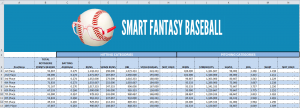Just as there will always be people searching for panacea weight loss pills, there will always be fantasy baseball players looking for simple fixes. Some will fall victim to the hype machine (picking up every minor league call up with an iota of name recognition) and others will chase stats (picking up the bench player that hit three home runs last week, or my favorite, picking up a random long reliever that lucked into a save the night before due to pitching several innings in a blow out win).
And just as a long-term weight loss plan based on the fundamentals of exercise and diet is more likely to be successful than a pill, fact-based fantasy research and long-term thinking will be more successful than pursuing the flavor of the week.
Even better is a fantasy approach that will allow you to identify the “future flavors of the week” and pick them up before others even think to. There’s nothing worse than having worked hard to stock your team’s “Watch List” only to be outraced by vulture league mates with Twitter access and quick trigger fingers.
Stacking The Odds In Your Favor
I prefaced this article with a discussion of the vultures. But it’s not just the vultures you’re up against. You probably have two or three other managers in your league that think similarly to you and value players consistent with you.
You’re in a competition for talent with 11 other managers. Some skilled. Some not. It makes a great deal of sense to set your horizon of identifying future impact players just a bit further than everyone else in your league.
“Who will Be The Hot Pickup Next Week?”
This is the line of thinking to use. I prefer this proactive approach in determining which player to pick up (who will be playing effectively in the near future) to a reactive approach (who was hot last week or who are the fantasy experts currently telling everyone to pick up).
How Do I Switch to This Proactive Approach?
To a large extent, reading and consuming fantasy baseball advice will lead to reactionary behavior. While consuming this fantasy advice is a very valuable thing to do, in terms of valuing players and being aware of what others are likely reading or listening to, it usually involves news about what happened yesterday. It is news about who is hot, who is cold, whose fastball has lost velocity, who got called up to the majors, etc. It is updated rankings, it is “who would you rather have”.
You can see how the focus is on the past or present. Again, some of this is good to know. It can help your team. It helps you know what others are thinking. But to create an advantage, attempt to shift your focus to the future.
My recommendation is a simple one – Be very up-to-date on your major league baseball news. Not your fantasy news. Your MLB news. Events in major league baseball are the driving force behind changes in opportunity and surroundings for players.
Baseball news precedes and drives fantasy news.
It’s pretty straightforward. A team beat writer is going to get the news about a player losing his spot in the lineup before a fantasy writer. The beat story might come out the night of the 21st. That story has to reach the fantasy community who will then Tweet about it later that night. They’ll then write columns about it on the 22nd, the next day. And then on the 24th they might include the news item and some analysis in a weekly podcast.
And all the while, you could have received the news yourself and intelligently analyzed the fantasy impact.
Sources For MLB News
I get nearly all of my MLB news from two locations – Twitter and Buster Olney.
I follow a handful of MLB writers and then at least one beat writer from each MLB team. To save you the trouble of identifying 30 beat writers and following them, you can check out the Smart Fantasy Baseball MLB News / Writers Twitter list (for more on Twitter lists and how to use them, read this).
I don’t necessarily read every tweet from each beat writer, but a few nights a week I might find myself scrolling threw the feed. It would a waste of time to read everything…
That’s a big reason why I try to read Buster Olney’s (follow Buster on Twitter) daily column when I can (here’s a link to his blog at ESPN, you do need to be an ESPN insider to read it). His daily column starts out with a feature story from the world of baseball. And then he launches into a series of quick hitters about injured players, moves & deals, the previous day’s games, and then a series of articles for each division in baseball. Each bullet has a link to a story on the web. It’s great. It’s efficient. You can scan through the whole thing in a couple of minutes.
What You’re Really Doing
A player’s skills are not going to change dramatically in a short period of time. So we’re really trying to identify changes in opportunity (playing time) and surroundings (new teams if traded, new spot in the lineup, etc.) for players.
Conclusion
Paying close attention to general baseball news can help shift your focus to a more proactive approach in identifying players to roster. This will allow you to make moves before your leaguemates and lead to more well-thought, long-term, strategic decisions.
Thanks for reading. Get Smart.









